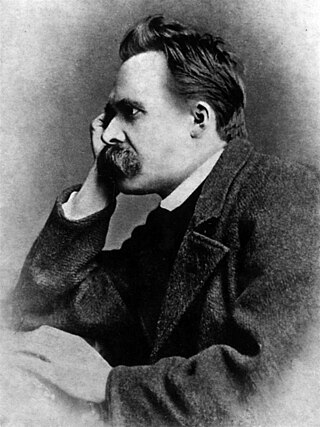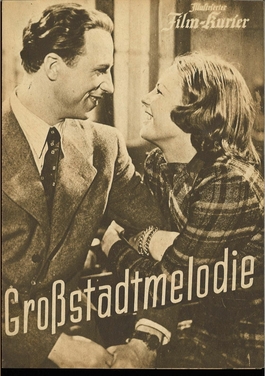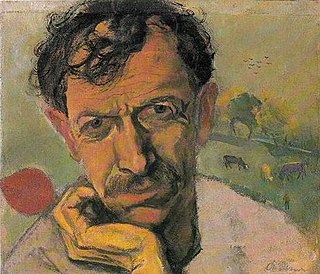Stirner may refer to:
- Max Stirner, pseudonym for Johann Caspar Schmidt (1806–1856), German philosopher and journalist
- Karl Stirne (painter) (1882–1943), painter, illustrator and poet
- Karl Stirner (1923–2016), American-German sculptor
Stirner may refer to:
Individualist anarchism is the branch of anarchism that emphasizes the individual and their will over external determinants such as groups, society, traditions and ideological systems. Although usually contrasted to social anarchism, both individualist and social anarchism have influenced each other. Mutualism, an economic theory particularly influential within individualist anarchism whose pursued liberty has been called the synthesis of communism and property, has been considered sometimes part of individualist anarchism and other times part of social anarchism. Many anarcho-communists regard themselves as radical individualists, seeing anarcho-communism as the best social system for the realization of individual freedom. Economically, while European individualist anarchists are pluralists who advocate anarchism without adjectives and synthesis anarchism, ranging from anarcho-communist to mutualist economic types, most American individualist anarchists advocate mutualism, a libertarian socialist form of market socialism, or a free-market socialist form of classical economics. Individualist anarchists are opposed to property that gives privilege and is exploitative, seeking to "destroy the tyranny of capital – that is, of property" by mutual credit.

Johann Kaspar Schmidt, known professionally as Max Stirner, was a German post-Hegelian philosopher, dealing mainly with the Hegelian notion of social alienation and self-consciousness. Stirner is often seen as one of the forerunners of nihilism, existentialism, psychoanalytic theory, postmodernism and individualist anarchism.

The Ego and Its Own, also translated as The Unique and its Property, is an 1844 work by German philosopher Max Stirner. It presents a post-Hegelian critique of Christianity and traditional morality on one hand; and on the other, humanism, utilitarianism, liberalism, and much of the then-burgeoning socialist movement, advocating instead an amoral egoism. It is considered a major influence on the development of anarchism, existentialism, nihilism, and postmodernism.

Freiherr Hans Guido von Bülow was a German conductor, virtuoso pianist, and composer of the Romantic era. As one of the most distinguished conductors of the 19th century, his activity was critical for establishing the successes of several major composers of the time, especially Richard Wagner and Johannes Brahms. Alongside Carl Tausig, Bülow was perhaps the most prominent of the early students of the Hungarian composer, virtuoso pianist and conductor Franz Liszt; he gave the first public performance of Liszt's Sonata in B minor in 1857. He became acquainted with, fell in love with and eventually married Liszt's daughter Cosima, who later left him for Wagner. Noted for his interpretation of the works of Ludwig van Beethoven, he was one of the earliest European musicians to tour the United States.
Schmidt is a common German occupational surname derived from the German word "Schmied" meaning "blacksmith" and/or "metalworker". This surname is the German equivalent of "Smith" in the English-speaking world.

Max Adler was an Austrian jurist, politician and social philosopher; his theories were of central importance to Austromarxism. He was a brother of Oskar Adler.
Johann Schmidt may refer to:

The ideas of 19th-century German philosophers Max Stirner and Friedrich Nietzsche have often been compared and many authors have discussed apparent similarities in their writings, sometimes raising the question of influences. In Germany, during the early years of Nietzsche's emergence as a well-known figure the only thinker discussed in connection with his ideas more often than Stirner was Arthur Schopenhauer. It is certain that Nietzsche read about Stirner's book The Ego and Its Own, which was mentioned in Friedrich Albert Lange's History of Materialism and Critique of its Present Importance (1866) and Eduard von Hartmann's Philosophy of the Unconscious (1869), both of which young Nietzsche knew very well. However, there is no irrefutable indication that he actually read it as no mention of Stirner is known to exist anywhere in Nietzsche's publications, papers or correspondence.

Egoist anarchism or anarcho-egoism, often shortened as simply egoism, is a school of anarchist thought that originated in the philosophy of Max Stirner, a 19th-century philosopher whose "name appears with familiar regularity in historically orientated surveys of anarchist thought as one of the earliest and best known exponents of individualist anarchism".
Karl Ballmer was a Swiss painter, anthroposophical philosopher, and writer.
Individualist anarchism in Europe proceeded from the roots laid by William Godwin and soon expanded and diversified through Europe, incorporating influences from individualist anarchism in the United States. Individualist anarchism is a tradition of thought within the anarchist movement that emphasize the individual and his or her will over external determinants such as groups, society, traditions, and ideological systems. While most American individualist anarchists advocate mutualism, a libertarian socialist form of market socialism, or a free-market socialist form of classical economics, European individualist anarchists are pluralists who advocate anarchism without adjectives and synthesis anarchism, ranging from anarcho-communist to mutualist economic types.
The relation between anarchism and Friedrich Nietzsche has been ambiguous. Even though Nietzsche criticized anarchists, his thought proved influential for many of them. As such "[t]here were many things that drew anarchists to Nietzsche: his hatred of the state; his disgust for the mindless social behavior of 'herds'; his anti-Christianity; his distrust of the effect of both the market and the State on cultural production; his desire for an 'übermensch'—that is, for a new human who was to be neither master nor slave".
Max Stirner's idea of the "Union of egoists" was first expounded in The Ego and Its Own. A union of egoists is understood as a voluntary and non-systematic association which Stirner proposed in contradistinction to the state. Each union is understood as a relation between egoists which is continually renewed by all parties' support through an act of will. The Union requires that all parties participate out of a conscious egoism. If one party silently finds themselves to be suffering, but puts up and keeps the appearance, the union has degenerated into something else. This union is not seen as an authority above a person's own will, but a voluntary relation subordinate to the wills of its members. This idea has received interpretations for politics, economics, romance and sexual relations.

Carl Friedrich Wilhelm Jordan, sometimes shortened to Wilhelm Jordan, was a German writer and politician.
German individualist philosopher Max Stirner became an important early influence in anarchism. Afterwards Johann Most became an important anarchist propagandist in both Germany and in the United States. In the late 19th century and early 20th century there appeared individualist anarchists influenced by Stirner such as John Henry Mackay, Adolf Brand and Anselm Ruest and Mynona.
Karl Stirner was a Germany-born American sculptor known internationally for his metalwork. His work has been shown at the Museum of Modern Art in New York, the Pennsylvania Academy of Fine Arts, the Philadelphia Museum of Art, the Corcoran Gallery of Art, the La Jolla Museum of Contemporary Art, the James A. Michener Art Museum, the Grounds for Sculpture in Hamilton, New Jersey, the Delaware Art Museum, and other locations. Stirner also participated in exhibitions in Taiwan, Hungary, and Italy.

The German Ideology is a set of manuscripts originally written by Karl Marx and Friedrich Engels around April or early May 1846. Marx and Engels did not find a publisher, but the work was later retrieved and published for the first time in 1932 by David Riazanov through the Marx-Engels Institute in Moscow. The first part of the book is an exposition of Marx's "materialist conception of history", though recent research for the new Marx Engels Gesamtausgabe (MEGA) indicates that much of the 'system' in this part was created afterwards by the Marx-Engels Institute in Moscow in the 1930s, from the set of manuscripts written by Karl Marx and Friedrich Engels. Much of the rest of the book consists of many satirical polemics against Bruno Bauer, other Young Hegelians, and Max Stirner's The Ego and Its Own (1844).

The Young Hegelians, or Left Hegelians (Linkshegelianer), or the Hegelian Left, were a group of German intellectuals who, in the decade or so after the death of Georg Wilhelm Friedrich Hegel in 1831, reacted to and wrote about his ambiguous legacy. The Young Hegelians drew on his idea that the purpose and promise of history was the total negation of everything conducive to restricting freedom and reason; and they proceeded to mount radical critiques, first of religion and then of the Prussian political system. They rejected anti-utopian aspects of his thought that "Old Hegelians" have interpreted to mean that the world has already essentially reached perfection.

Melody of a Great City is a 1943 musical drama film directed by Wolfgang Liebeneiner and starring Hilde Krahl, Werner Hinz and Karl John. A young woman moves to Berlin to work as a press photographer.

Karl Stirner was a German painter, watercolorist, illustrator and writer.